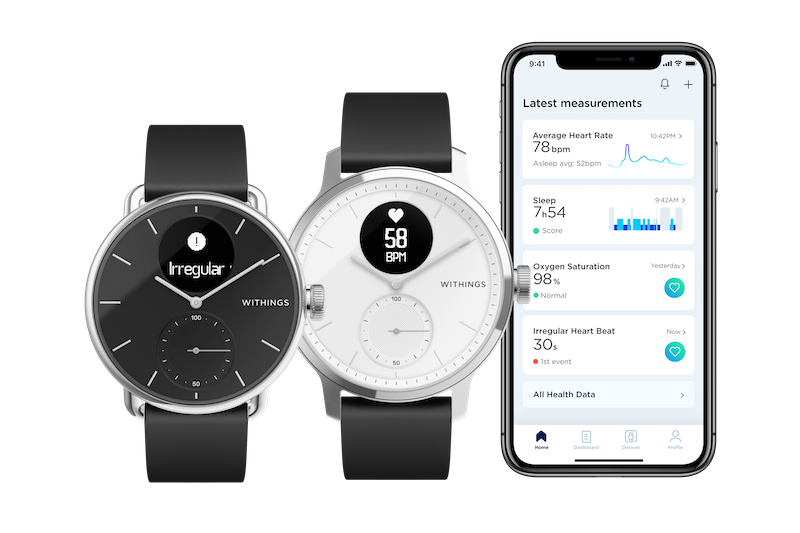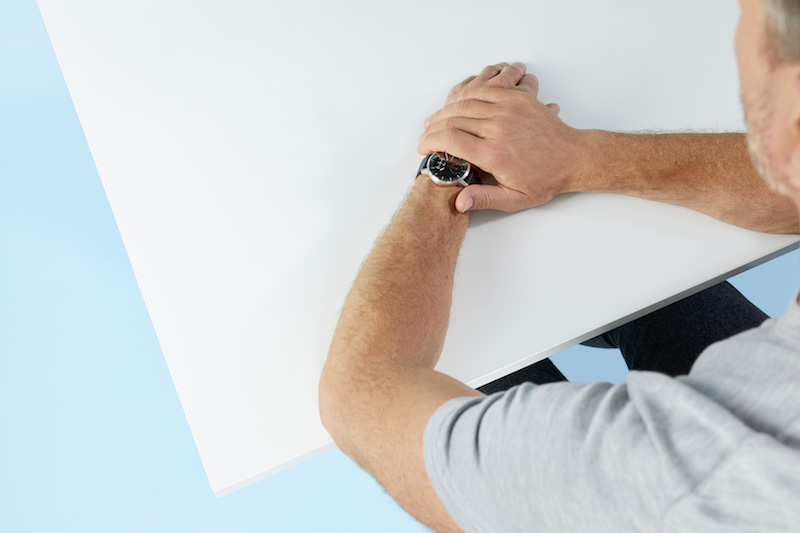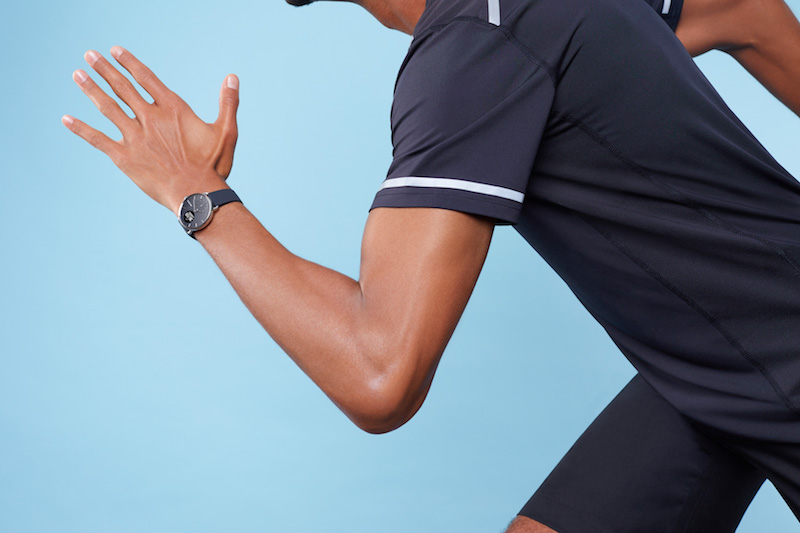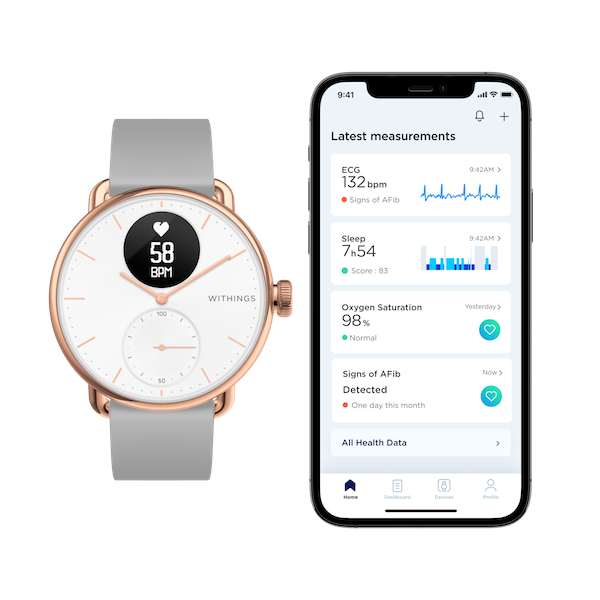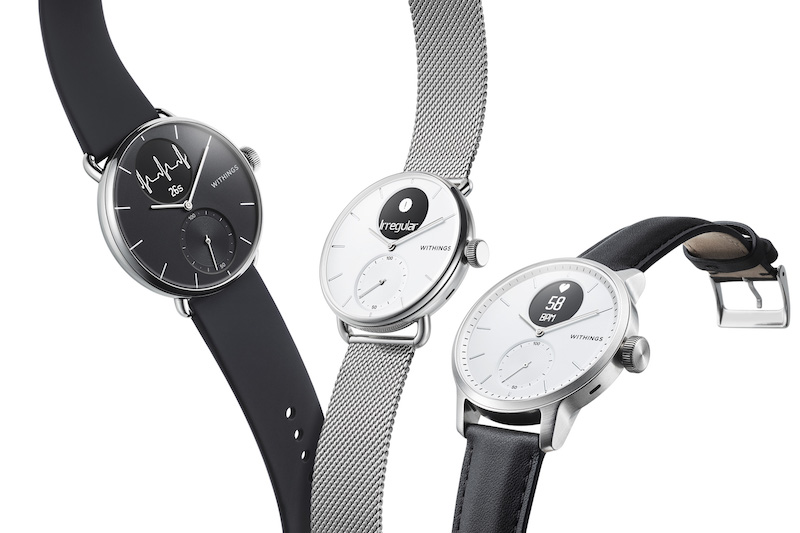The promise of a smart watch is wonderful, but there are certain limitations to these devices that have made them less than perfect: their tiny screen makes them challenging to use and their battery life is limited.
So, why not own a watch that tells time, monitors your health using sensors that need to be next to your skin, acts as a fitness tracker, has great battery life, and leaves the rest to the smart phone that you are going to carry anyway? With this in mind I tried out the Withings ScanWatch, a hybrid smart watch that incorporates advanced health monitoring, fitness tracking, and up to 30 days of battery life.
Withings is a French technology company specializing in the development and manufacture of health technology products. It was founded in 2008 and has offices in France, United States, and Hong Kong. Its product line includes smart watches with health sensors, smart scales, blood pressure monitors, a sleep monitor, and even a non-contact thermometer. However, Withings does much more than just design and sell these products to consumers. It also works to integrate the data collected by their products with medical professionals so physicians can better manage their patient’s health.
Withings ScanWatch Health Monitoring
The ScanWatch is Withings most advanced wearable health device. First, it is a clinically validated heart health monitor. It can perform an on-demand electrocardiogram (ECG), tracks the wearer’s heart rate every second during a workout to optimize training, measures blood oxygen saturation and monitors daily and nighttime heart rates.
The ScanWatch includes electrodes on the back of the watch as well as an electrode in the metal ring around the watch face. When the wearer places a finger on the metal ring, electrodes measure the electrical activity of the heart in the form of an ECG.
Whereas, an ECG in a doctor’s office is measured using 12 wires (leads) connected to different parts of a person’s body, the ScanWatch is referred to as a “single lead” ECG as it just measures the electrical activity of the heart between the wrist where the watch is being worn and the wearer’s other hand that is rested on the watch in contact with the ScanWatch’s outer ring. Obviously, the data collected by the ScanWatch is much more limited than what can be collected by a 12 lead ECG in a doctor’s office. For example, the ScanWatch cannot detect a heart attack.
The ScanWatch’s ECG can detect signs of atrial fibrillation (A-fib), which is an irregular and often very rapid heart rhythm (arrhythmia) that can lead to blood clots in the heart. A-fib increases the risk of stroke, heart failure, and other heart-related complications.”
A-Fib is often not diagnosed in people because it may come and go. So, the ability to capture an ECG whenever the wearer feels any sign of their heart beating irregularly can help diagnose this issue very quickly.
The ScanWatch also includes a multi-wavelength PPG sensor to measure blood oxygen saturation (SpO2) from the wearer’s wrist in only 30 seconds. A normal blood oxygen saturation level is between 95% and 100%. However, it can be significantly impacted by lung disease or COVID-19.
At night the ScanWatch can perform a respiratory wellness scan that includes measurements of heart rate, heart rhythm, respiratory rate, respiratory effort, and oxygen saturation throughout the night to provide a complete mapping of the wearer’s sleep pattern. The ScanWatch also measures the cycles of a wearer’s sleep using data from an accelerometer built into the ScanWatch. Combining this data, the ScanWatch can detect breathing disturbances that can impair your ability to sleep properly for your body to recover during the night.
In addition, the ScanWatch will track your sleep cycles and provide a cumulative sleep score based on those cycles, duration, regularity, and disruptions. The sleep score provides the wearer with an easy to understand metric of their sleep quality each night.
All of the above has been validated in multiple clinical studies. In fact, the ScanWatch has been cleared by the U.S. Food and Drug Administration (FDA) for its oximetry and ECG features.
Withings ScanWatch Activity Tracking
The ScanWatch also provides the features people need to track their activity, monitor their exercise sessions, and to achieve their fitness goals. First, the ScanWatch can automatically detect whether you are walking, running, or participating in up to 30 different activities.
The ScanWatch will use GPS data from the wearer’s smart phone to map the exercise session, including the duration, distance, pace, elevation, and calories burned. All of this data is available in the Withings Health Mate app or can be integrated with partner apps, including Apple Health, Google Fit, MyFitnessPal, and RunKeeper.
Finally, the ScanWatch will assess your fitness level based on an estimate of your maximal oxygen consumption (VO2 Max). Wikipedia defines VO2 Max as “(maximal oxygen consumption, maximal oxygen uptake or maximal aerobic capacity) is the maximum rate of oxygen consumption measured during incremental exercise; that is, exercise of increasing intensity.”
Hands on with the Withings ScanWatch
The Withings ScanWatch is packaged in a simple cardboard box and comes with a soft fabric travel case, magnetic charging cable, elastomer sport wrist band, quick installation guide, and ScanWatch information guide.
After charging the ScanWatch, I went through the process of adding the ScanWatch to the free Withings Health Mate App that I had already installed on my phone from prior reviews I have done of other Withings products. The app immediately detected the watch and stepped me through the process of:
- Pairing the device with my phone
- Selecting which family member configured in the app who would be using the ScanWatch
- Performing a firmware update on the ScanWatch
- Automatically setting the time on the ScanWatch by moving the hands to the correct time
Finally, the watch walked me through a series of tutorials on the operation of the watch, including taking my first ECG and measuring my blood oxygen saturation.
The face of the ScanWatch resembles a standard analog watch, but there are some significant differences. First, you never have to set the watch by turning the watch’s crown. Instead the hands are fully motorized and will automatically move to the correct time.
Second, on many standard watches there is small circular face with a single hand that counts down the seconds. The ScanWatch includes this same small circular face with a single hand on the lower half of the watch’s face. However, instead of counting off the seconds, it measures your progress toward your daily exercise goal.
Finally, there is a small, circular, digital display in the upper half of the watch face. This face is activated by pressing the crown of the watch. When the crown is first pressed, the display shows the current time, day, and date. Then, when you turn the crown, it steps through the different functions available including:
- Displaying your last measured heart rate
- Displaying the number of steps that you have taken that day
- Displaying the number of miles traveled
- Displaying the altitude gained as the number of floors you have climbed
- Performs an ECG
- Measures your blood oxygen saturation (SPO2)
- Triggers the start of a workout and the selection of the type of workout that you will be performing. Optionally, a workout can be triggered by a long press of the crown.
- Guides your breathing from one to five minutes allowing you to refocus and relax
- Turns the alarm on/off or activates the stopwatch
- Switches to Settings, where you can view the battery life, turn do-not-disturb on/off, “Quicklook” on/off (allows you to automatically turn the display of the watch on when you raise your wrist), Hands on/off (automatically moves the watch hands to the 10:10 clock position when the display is activated so they don’t block the user’s view of the display)
- Calories burned
The above list of functions can be customized using the Withings Health Mate app. You can re-order the items in the list or remove items you don’t want displayed.
ECG Measurement
As described above, an ECG is the measurement of the electrical activity of the heart. Taking your ECG with the ScanWatch is very simple.
- Select the ECG function by pressing the crown
- Turn the crown until ECG is displayed on the ScanWatch display
- Press the crown to begin the ECG measurement
- Relax
- Place your hand across the face of the watch so it is in contact with the outer metal ring of the ScanWatch but leaving enough room so you can still see the display
- The display will count down 30 seconds as it collects data on the electrical activity of your heart
- When completed, the display will tell you if your ECG is normal, shows A-Fib, or if the ScanWatch was unable to accurately collect data; possibly because you were moving too much during the data collection process
Using the Withings Health Mate app, you can then replay the entire ECG, share the ECG as a PDF with a medical professional, or share a complete health report based on all the data collected by the ScanWatch as a PDF with a medical professional.
Blood Oxygen Saturation Measurement
Measuring your blood oxygen saturation with the ScanWatch is, again, very simple.
- Select the SPO2 function by pressing the crown
- Turn the crown until SPO2 is displayed on the ScanWatch display
- Press the crown to begin the SPO2 measurement
- Relax
- Place your hand across the face of the watch so it is in contact with the outer metal ring of the ScanWatch but leaving enough room so you can still see the display
- The display will count down 30 seconds as it collects data
- When complete the display will display your blood saturation, tell you if it is normal, and display your heart rate.
Blood oxygen saturation measurements are integrated into the sleep tracking and fitness tracking functions of the ScanWatch.
Sleep Tracking
The Withings ScanWatch automatically tracks your sleep at night. The information collected can be viewed in the Withings Health Mate app.
First, and foremost, a sleep score is calculated based on the other data collected by the ScanWatch. The sleep score provides an intuitive way for a user to quickly understand the quality of their sleep. The sleep score is based on four metrics
- The total time spent sleeping
- The consistency in the times you go to bed and get up
- The amount of time you spent in deep, restorative sleep
- The time you spent awake during the night
In addition, the Health Mate app provides information on:
- Breathing disturbances, including snoring
- A graph of your heart rate throughout the night
Breathing disturbances are detected through the ScanWatch’s motion sensor, measurements of blood oxygen level, and pulse rate measurements during the night.
The Withings app allows you to track your sleep heart rate over time as it is an indicator of your overall cardiovascular fitness and health. In the Health Mate app, you can view graphs of your heart rate on a nightly, quarterly, or yearly basis. The app will also display whether your sleep heart rate is trending upwards or downwards.
Fitness Tracking
Another important feature of the ScanWatch is fitness tracking. The ScanWatch includes presets for tracking 41 different forms of exercise including, running, swimming (the ScanWatch is waterproof at depths up to 50 meters), cycling, walking, hiking, weightlifting, yoga, pilates, tennis, soccer, and golf.
Testing the fitness tracking capabilities of the ScanWatch proved to be a challenge. A 30,000-plus acre wildfire less than an hour drive from my home turned our normally pristine air into a haze of smoke. With air quality readings in the hazardous range, my normal workout of mountain biking became out of the question. While the indoor air quality was better, it still wasn’t good enough that I wanted to work out. Finally, the wind shifted, and the air quality improved enough, for a few hours, to go on a mountain bike ride.
First, I tried the ScanWatch’s automatic activity detection feature. This didn’t work as well as I would have liked. The ScanWatch is advertised as being able to detect 13 different activities including walking, cycling, tennis, and dance. What I found was that the ScanWatch would eventually detect that I was cycling. But it took quite some time for it to do this and a significant portion of the data from my workout wasn’t captured.
After giving it some thought, I realized that there was little difference between my cycling down the street on a bike with my hands on the handlebars and driving down the same street with my hands on the steering wheel of my car. The only real difference would be that my heart rate would be elevated on the bike. With this in mind, I understood the challenge of automatically detecting that I was cycling. I was much more successful when I simply triggered the start of the workout using the crown on the ScanWatch with the ScanWatch display.
During the ride I could optimize the quality of data collected by pausing the activity whenever I stopped riding and restarting when I continued. This is easily accomplished by simply pressing the crown and selecting the displayed pause symbol followed by selecting the play symbol to continue with the ride. Similarly, you press the crown and select the stop symbol when you are finished.
With the ScanWatch connected to my smart phone’s GPS through Bluetooth, the ScanWatch captured the route of my ride and a map of it was displayed in the Withings Health Mate app. In addition, in the app I could view:
- Duration of my ride
- Miles traveled
- Average speed
- Maximum speed
- Calories burned
- Average heart rate
- A graph of my speed and elevation changes over the course of the ride
- A graph of my heart rate throughout the duration of the ride
- A graph showing the amount of time my heart rate was in different zones (peak, intense, moderate, and light)
The app also allows the user to attach photos to the workout session and type in notes. Finally, there is the ability to set a weekly goal for my cycling activity.
For running and walking workouts when the ScanWatch is connected to a smart phone for GPS tracking, a calculation of VO2 max is performed and available in the Health Mate app. In the app, the VO2 max value is labeled as the individual’s “Fitness Level.”
VO2 Max is the maximum rate that your body can use oxygen during exercise. The value is a combination of fitness and genetics. Individuals can improve their ability to absorb oxygen through exercise and training. However, professional athletes, such as the cyclists that compete in the Tour de France, have VO2 max levels that are beyond the capabilities of the average person.
The only other challenge I encountered using the ScanWatch during the bike ride is that, without my reading glasses, I found it difficult to operate the workout functions on the watch given the size of the display. It isn’t a matter of if you are eventually going to crash when mountain biking, it is only a matter of when. Because of this, and the fact I only need glasses for reading, I choose not to wear expensive prescription glasses when riding. Instead, I just wear less expensive, over-the-counter sunglasses.
The ScanWatch can be configured so a press-and-hold of the crown automatically switches the watch to the activity selector. With this configured, and some time to memorize the sequence of steps turning and pressing the crown to start a cycling workout, I expect it won’t be hard to overcome this problem. The pause, play, and stop symbols are big enough that I can see those without my glasses.
Overall, the ScanWatch provides the user with a great deal of health data related to a workout.
Integration
The Withings Health Mate app offers a wide range of features and also integrates with other Withings products, including their line of smart scales and their blood pressure gauge. However, for people who want to use other health and fitness apps, Withings offers integration with a wide range of other popular apps including, but not limited to, Apple Health, Google Fit, IFTTT, Strava, MyFitness Pal, Nest, RunKeeper, Fitbit, and WebMD.
In addition, Withings has an open API (application programming interface) to allow anyone with software development skills to write their own software that leverages their health data.
Other Features
The ScanWatch can be configured to vibrate in response to notifications from a wide range of apps. For example, I configured the ScanWatch to vibrate in response to text messages, phone calls, and notifications from Pushover, which I use to receive notifications from my smart home. The ScanWatch would even display text messages and the short text from Pushover notifications telling me, for example, that my clothes dryer had finished drying my clothes.
The ScanWatch can wake you up at the optimal time, based on your schedule and sleep cycle. After selecting the time that your alarm clock would normally go off, the ScanWatch will choose the best time to wake you up — using a light vibration — within 20 minutes of your normal wakeup time, based on the stage of sleep that you are in.
The ScanWatch can optionally be configured to vibrate when it detects long periods of inactivity to help the wearer maintain, and improve, their fitness.
Style
The Withings ScanWatch looks like a classic analog watch; not a smart watch. It is available in a width of either 38mm or 42mm. The 38mm ScanWatch is available with a white or black face and a polished silver case. The 38mm ScanWatch is also available with a white or blue face and a polished gold case. The 42mm ScanWatch is available with a black or white face and a brushed silver case. While the black circular digital display stands out on the white face of the ScanWatch, it blends in with the black face and a casual observer would have no idea you were wearing a smart watch.
A wide variety of optional bands can also be purchased for a ScanWatch including a variety of different silicone bands, leather bands, recycled woven P.E.T fabric bands, mesh metal bands, and linked metal bands.
Finally, the ScanWatch has a sapphire glass crystal. This is the same kind of glass that is used on high-end watches, including those from Rolex.
Withings also offers the ScanWatch Horizon. The Horizon is a premium version of the ScanWatch with a rotating bezel, heavy duty, machined stainless steel case, linked metal watch band, and is waterproof to 100 meters. It also comes with a five-year warranty.
Conclusions
The Withings ScanWatch is a very well-designed tool for monitoring your health and fitness. The blood oximetry and ECG measurement capabilities are FDA approved, and the watch has gone through extensive clinical trials. Leveraging these capabilities for fitness tracking, sleep tracking, and A-Fib detection adds real value to a user. In addition, the 30-day battery life sets it apart in convenience compared to a smart watch.
Even with these advanced features, the ScanWatch is easy to use and the Heath Mate app provides extensive help capabilities that allow a person without a medical background to use the product.
From a usability standpoint, I only have one minor complaint. I do wish that the hands on the ScanWatch glowed in the dark to allow you to easily read the time at night. You can press the crown to display the date and time on the ScanWatch’s small display. But, without my reading glasses, that really doesn’t help. If the hands and hour markers glowed, it would address this issue and make an excellent product even better.



